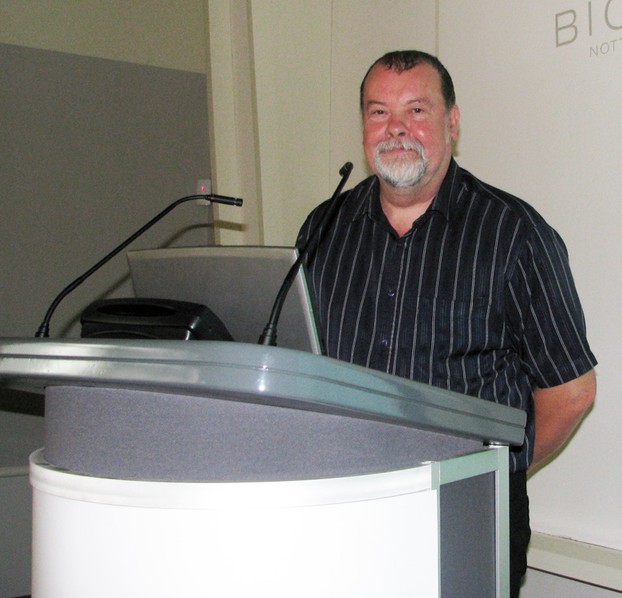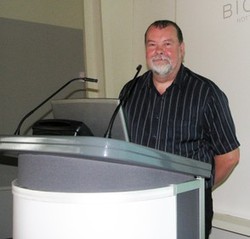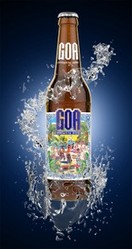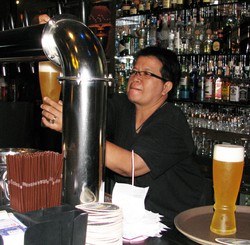Once yeast was the boss when it came to brewing beer; it did what it did and brewers has to accept that. But now researchers are looking at how the yeast actually works and how it can be altered to make it work better. Chris Boulton, at a lecture in Nottingham, explained how the work was progressing.

Why yeast is no longer boss in beer brewing
Research at Nottingham University is looking into ways that yeast can improve the brewing process
 Chris Boulton gives a yeasty talk at Nottingham's Biocity Photo by Steve Rogerson |
Researchers at the University of Nottingham in the UK are studying the yeast genome to find ways to improve the flavour of beer. But don't worry, this is not genetic engineering but looking at information they gained when considering genetic engineering to find ways to alter the brewing process in a way that lets the yeast produce new flavours naturally.
Chris Boulton, a teaching fellow in brewing science at the university, discussed the work that was being done at a seminar at Biocity in Nottingham in 2012. He started by explaining that beer is basically an alcoholic beverage made by the fermentation of an aqueous extract of malted barley and usually flavoured with hops. However, everything on that list is changeable. There are non-alcoholic beers, not all use malted barley (wheat, oats, rice, sorghum, sugar itself and syrups have all been used as the source of the sugar), and not all are flavoured with hops.
But what all beer has in common is that the catalyst for the fermentation is one or more strains of yeast.
Origins of yeast in brewing
"This is the world's oldest biotechnology process," Boulton told the audience. "Its origins can be traced back to Sumeria - now known as Iraq - in 5000BC. Beer is now brewed in 169 countries and 160 billion litres a year are produced worldwide."
But brewers brewed beer using yeast before they even knew what yeast was. They knew that if they left the mix of sugars produced from malted barley it would eventually start to ferment. They called the mystery "godisgoode", which became an early word for yeast in both baking and brewing.
Types of yeast
There are basically two types of yeast used in brewing. The yeast for producing ale is saccharomyces cerevisiae and the yeast for producing lager a hybrid of the ale yeast and saccharomyces bayanus, which is used for making cider and wine. The main difference in brewing is that the ale yeast rises to the top and the lager yeast sinks to the bottom, hence the terms top and bottom fermenting. The ale yeast is normally fermented at a higher temperature.
"There are through many thousands of brewing strains of these yeasts," said Boulton, "and most breweries have their own strains that they guard, with each strain giving a slightly different beer flavour."
But he said that because most of the brewing was concentrated in a small number of large companies, there was a move towards making these big mass-produced beers more consistent, and that was what was driving the move to look at the yeast more closely. Mapping the yeast genome is not new - this was done by the early 1990s. And it is possible to make alterations in the genome that would affect the flavour of the beer. However, the brewers rejected going down that route because of the public opposition to genetically modified food.
Current research
Current research therefore is looking at the maps of the genome to see what can be changed in the brewing conditions. Take, say, one element in the genome that you know produces a certain flavour but only very slightly in the normal brewing process. If you cannot use genetic engineering to make it produce more of that flavour, what you can do is look under what circumstances it would produce more of that flavour naturally, such as if the brewing is done at different temperatures or pressures.
This is not a simple process as there are many elements within a particular yeast strain and altering the process to change one of those elements will also change the others and not necessarily in a good way. But progress is being made.
"You can generate the conditions to make the yeast do what you wish," said Boulton. "Once yeast was boss. It did what it did. Now it is nice to see that change."
He also said they have learnt that the factors affecting the end result in brewing are so many that it is hard to achieve consistency for beer brewed in different places.
"There are so many factors involved in making beer and the flavours involved that it is almost impossible to take a beer and brew it somewhere else without a slight change in flavour and often not so slight," he said.
Now, maybe someone should tell the brewers that. There have been many examples of brewery takeovers in the UK resulting in the closing down of the brewery and production of certain beers moved to another brewery while pretending that it is the same beer.
Finally, for those who like brewing their own beer, Boulton recommends the yeast that you find in the bottom of a bottle of White Shield as a good one to use.
You might also like
Goa Premium Beer: Lager hopes to cash in on gluten-free marketThe latest gluten-free product to hit the market is an Indian beer called Goa...
Full Moon Brewwork: A Microbrewery and Bar in Patong, Phuket, ...A look at the range of craft beers brewed at the Full Moon Brewwork microbrew...






 KZine Issue 31: Review of October 2021 Issueon 11/07/2021
KZine Issue 31: Review of October 2021 Issueon 11/07/2021
 KZine Issue 30: Review of June 2021 Issueon 07/05/2021
KZine Issue 30: Review of June 2021 Issueon 07/05/2021
 KZine Issue 29: Review of February 2021 Issueon 02/23/2021
KZine Issue 29: Review of February 2021 Issueon 02/23/2021
 KZine Issue 28: Review of September 2020 Issueon 10/01/2020
KZine Issue 28: Review of September 2020 Issueon 10/01/2020



Comments
O Wise One [you deserve this epithet for writing about the much beloved brew!] has similar research been done on wine, cider and mead?
This was a really interesting article!
SteveRogerson, Thank you for product lines, pretty pictures and practical information.
Is the White Shield to which you refer Worthington's? The Wikipedia articles says that it has won CAMRA Champion Bottled Beer of Britain Gold more than any other beer.